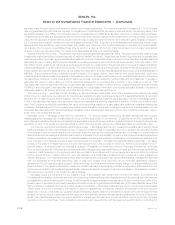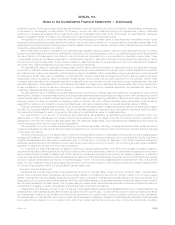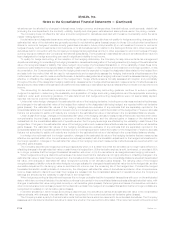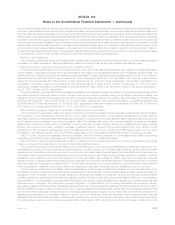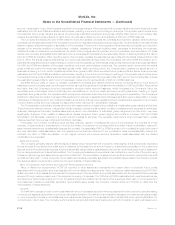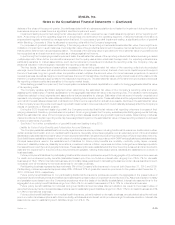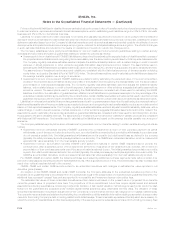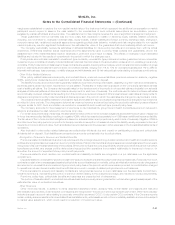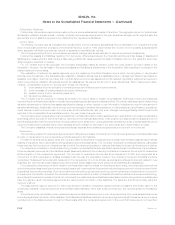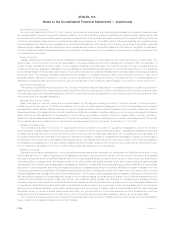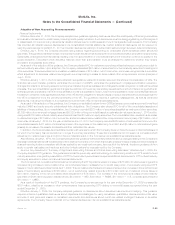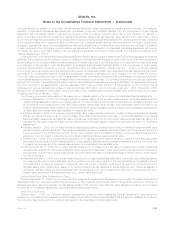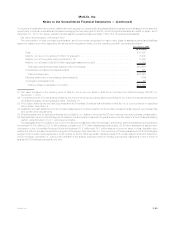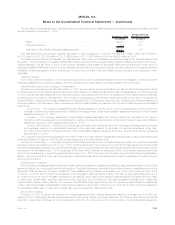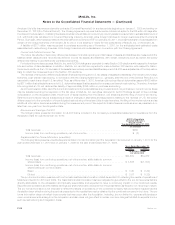MetLife 2010 Annual Report Download - page 111
Download and view the complete annual report
Please find page 111 of the 2010 MetLife annual report below. You can navigate through the pages in the report by either clicking on the pages listed below, or by using the keyword search tool below to find specific information within the annual report.Policyholder Dividends
Policyholder dividends are approved annually by the insurance subsidiaries’ boards of directors. The aggregate amount of policyholder
dividends is related to actual interest, mortality, morbidity and expense experience for the year, as well as management’s judgment as to the
appropriate level of statutory surplus to be retained by the insurance subsidiaries.
Income Taxes
The Holding Company and its includable life insurance and non-life insurance subsidiaries file a consolidated U.S. federal income tax
return in accordance with the provisions of the Internal Revenue Code of 1986, as amended (the “Code”). Non-includable subsidiaries file
either separate individual corporate tax returns or separate consolidated tax returns.
The Company’s accounting for income taxes represents management’s best estimate of various events and transactions.
Deferred tax assets and liabilities resulting from temporary differences between the financial reporting and tax bases of assets and
liabilities are measured at the balance sheet date using enacted tax rates expected to apply to taxable income in the years the temporary
differences are expected to reverse.
For U.S. federal income tax purposes, the Company anticipates making an election under the Code Section 338 as it relates to the
Acquisition. As such, the tax basis in the acquired assets and liabilities is adjusted as of the Acquisition Date resulting in a change to the
related deferred income taxes.
The realization of deferred tax assets depends upon the existence of sufficient taxable income within the carryback or carryforward
periods under the tax law in the applicable tax jurisdiction. Valuation allowances are established when management determines, based on
available information, that it is more likely than not that deferred income tax assets will not be realized. Significant judgment is required in
determining whether valuation allowances should be established, as well as the amount of such allowances. When making such deter-
mination, consideration is given to, among other things, the following:
(i) future taxable income exclusive of reversing temporary differences and carryforwards;
(ii) future reversals of existing taxable temporary differences;
(iii) taxable income in prior carryback years; and
(iv) tax planning strategies.
The Company may be required to change its provision for income taxes in certain circumstances. Examples of such circumstances
include when the ultimate deductibility of certain items is challenged by taxing authorities (see Note 15) or when estimates used in determining
valuation allowances on deferred tax assets significantly change or when receipt of new information indicates the need for adjustment in
valuation allowances. Additionally, future events, such as changes in tax laws, tax regulations, or interpretations of such laws or regulations,
couldhaveanimpactontheprovisionforincometaxandtheeffectivetaxrate.Anysuchchangescouldsignificantlyaffecttheamounts
reported in the consolidated financial statements in the year these changes occur.
The Company determines whether it is more likely than not that a tax position will be sustained upon examination by the appropriate taxing
authorities before any part of the benefit can be recorded in the financial statements. A tax position is measured at the largest amount of
benefit that is greater than 50 percent likely of being realized upon settlement. Unrecognized tax benefits due to tax uncertainties that do not
meet the threshold are included within other liabilities and are charged to earnings in the period that such determination is made.
The Company classifies interest recognized as interest expense and penalties recognized as a component of income tax.
Reinsurance
The Company enters into reinsurance agreements primarily as a purchaser of reinsurance for its various insurance products and also as a
provider of reinsurance for some insurance products issued by third parties.
For each of its reinsurance agreements, the Company determines whether the agreement provides indemnification against loss or liability
relating to insurance risk in accordance with applicable accounting standards. The Company reviews all contractual features, particularly
those that may limit the amount of insurance risk to which the reinsurer is subject or features that delay the timely reimbursement of claims.
For reinsurance of existing in-force blocks of long-duration contracts that transfer significant insurance risk, the difference, if any, between
the amounts paid (received), and the liabilities ceded (assumed) related to the underlying contracts is considered the net cost of reinsurance
at the inception of the reinsurance agreement. The net cost of reinsurance is recorded as an adjustment to DAC and recognized as a
component of other expenses on a basis consistent with the way the acquisition costs on the underlying reinsured contracts would be
recognized. Subsequent amounts paid (received) on the reinsurance of in-force blocks, as well as amounts paid (received) related to new
business, are recorded as ceded (assumed) premiums and ceded (assumed) future policy benefit liabilities are established.
For prospective reinsurance of short-duration contracts that meet the criteria for reinsurance accounting, amounts paid (received) are
recorded as ceded (assumed) premiums and ceded (assumed) unearned premiums and are reflected as a component of premiums and other
receivables (future policy benefits). Such amounts are amortized through earned premiums over the remaining contract period in proportion
to the amount of protection provided. For retroactive reinsurance of short-duration contracts that meet the criteria of reinsurance accounting,
amounts paid (received) in excess of (which do not exceed) the related insurance liabilities ceded (assumed) are recognized immediately as a
loss. Any gains on such retroactive agreements are deferred and recorded in other liabilities. The gains are amortized primarily using the
recovery method.
The assumptions used to account for both long and short-duration reinsurance agreements are consistent with those used for the
underlying contracts. Ceded policyholder and contract related liabilities, other than those currently due, are reported gross on the balance
sheet.
Amounts currently recoverable under reinsurance agreements are included in premiums, reinsurance and other receivables and amounts
currently payable are included in other liabilities. Such assets and liabilities relating to reinsurance agreements with the same reinsurer may be
recorded net on the balance sheet, if a right of offset exists within the reinsurance agreement. In the event that reinsurers do not meet their
F-22 MetLife, Inc.
MetLife, Inc.
Notes to the Consolidated Financial Statements — (Continued)


